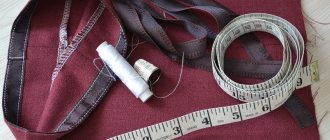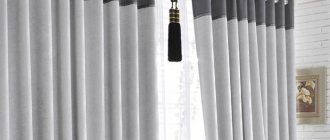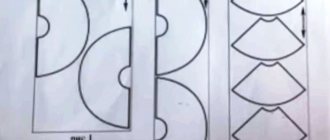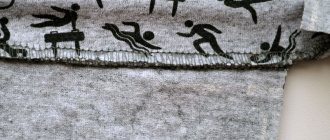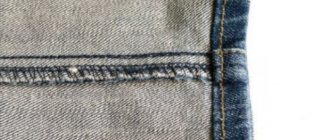Tulle is often chosen to decorate windows. This is a light and weightless curtain that gives a special coziness to the interior. Tulle does not always have the appropriate length. If you decide to hem tulle at home, then you should do this work carefully. This material is quite capricious and requires careful handling. You can hem the tulle by hand or using a sewing machine. In the second case, the seam will be neater. From this article you will learn how to hem tulle yourself at home.
How to correctly determine the length of tulle and cut the fabric
To properly trim the tulle, you should measure the distance from the floor to the hook on which the curtain will be hung. If you want the tulle to flow along the floor, allow an allowance of a few centimeters. The tulle should be shortened after it has hung on the cornice for 3 days. This will allow the material to fully expand.
Tulle is a slippery fabric, making it difficult to work with. You can shorten the material in a simple way. Pick up one thread and pull it out of the fabric, as in the photo below.
A line will be formed along which the cut will need to be made. If the fabric is too thin, it is recommended to cut along the grain line.
You can draw a cutting line using a pencil and ruler, and then draw a cut line along the fabric with a utility knife. Many synthetic fabrics tear easily. So you can cut the fabric from the edge, and then just tear the material with your hands.
How to make flowers from a veil for curtains with your own hands
To make flowers from fabric, small pieces of veil need to be treated with gelatin and sugar.
Description of solution preparation:
- a small pack of gelatin is poured into a glass and filled one third with cold water;
- the solution is left for 1 hour;
- after the gelatin grains swell, add boiling water to the brim of the glass;
- Add 1 teaspoon of sugar to the liquid and leave to cool.
The fabric is spread on a clean, flat surface. Then the warm composition is applied to the material. The treated pieces of the veil are dried indoors, since dust and insects may stick to the surface outside.
For the pattern you can take a rose or peony. The flower is completely disassembled, each petal is outlined on paper. This is how a stencil is created. All parts are numbered. After the fabric has dried, petals are cut out of it.
Rose from the veil
Assembling the flower starts from the center. A piece of cotton wool is attached with a thread to a wire and covered with a piece of fabric like a scarf. Several turns of thread are made at the base of the bud, then the flower is expanded with cut petals. Each new part is attached with thread and a drop of PVA glue.
Note! The petals can be molded before assembly. To do this, they are laid out on a pad of sand and pressed down in the middle with a heated spoon. The device must have a wooden handle, otherwise you can burn your hands. From ready-made flowers you can collect bouquets for curtain ties.
The veil is widely used by designers to create delicate, elegant draperies on windows and interior decorations. The fabric obediently lies down, taking the desired shape into swags and cascades. The material has a lot of advantages. The only drawback of the veil is its wrinkleability.
Tulle is a lightweight fabric for window decoration, which is sold in specialized stores in the form of cuts. Even a novice seamstress can turn it into beautiful light curtains, if you follow the instructions on how to sew tulle with your own hands.
Moscow seam
This seam is very popular and is performed using a sewing machine. The width of the hem is small, so that the fabric does not lose its lightness.
For hemming organza tulle and mesh, it is better to choose thread No. 40 and thinner. If the fabric is translucent, the thread color should be slightly lighter than the tulle. This way they will be almost invisible.
Bottom processing is performed in the following sequence:
- Turn the fabric 5 mm.
- Iron the hem.
- Sew the fabric 0.2 cm from the edge.
- Cut off the excess fabric 0.2 cm from the created stitch.
- Tuck the tulle.
- Run the iron along the hem again.
- Sew the fabric with an indentation of 2 mm from the first line.
This method of shortening curtains will save material on the hem.
General Tips
Hemming begins with determining the length of the finished product. To measure it more accurately, before cutting the tulle, it is recommended to hang it above the window and leave it for a while so that it takes its final shape.
Threads for all types of tulle are selected thin, No. 40 or less. It is desirable that they match the fabric composition: synthetic, silk, cotton.
The needles must be very sharp, since dull needles pull and tear the delicate fabric.
The color of the threads is chosen to match the tone of the main background. If this is not possible, you can take a thread a tone or two darker; it will be less noticeable on the canvas than a light one.
To properly hem curtains and tulle, before sewing a stitch on a sewing machine, experiment on a small piece of fabric: adjust the thread tension and stitch length. Please note that the seams are laid with a straight stitch with an average stitch length of 2-4 mm.
If you are not experienced enough in sewing, before final stitching each time, baste the folds (or pin them with safety pins) and iron the hems and finished seams with an iron.
While sewing, try not to tighten the thread too much, otherwise the thin, delicate fabric may warp.
To ensure an even stitch, hem the tulle with paper. Cut a strip with a width equal to the width of the hem and, placing one side of it against the fold, stitch along the other side.
It is convenient to hem very thin or mesh curtains on tissue paper. After stitching, the paper comes off easily.
Bias tape
This processing option is more suitable for mesh and embroidered fabrics. You can buy bias tape at a fabric store. For hemming, a snail foot or a special foot is used. The work is performed in the following sequence:
- Cut the tulle to the required length.
- Place the cut into the binding.
- If you have sewing experience, you can start processing without basting the fabric. But it’s better to baste or secure the tape with pins.
- Start sewing the binding on using a straight stitch. While working, it is recommended to stop from time to time and check the quality of the seams on both sides.
- Hold the fabric with your hands, it will be easier for you to control the seam.
- If the stitching is done evenly, you will get a beautiful tulle edge.
Shortening tulle with weighting
Among the huge selection of materials produced by modern manufacturers, you can find weighted tulle. It looks like an overlock stitch. It contains a cord with heavy beads fastened with thread.
The weighting agent pulls the fabric down, allowing the curtain to hold its shape perfectly.
Making cuts on the sides is easy. However, this process has certain nuances. Let's look at this edge processing option step by step:
- We cut the curtains to the required height. When shortening the material, consider the width of the curtain tape. To shorten the fabric evenly, just make a small cut with scissors and pull the thread out of the fabric. A boundary is formed along which the material can be shortened.
- To make it easier to process side cuts, it is better to cut the cord. If you plan to fold the fabric twice on the sides by 20 mm, then the weighting material will have to be cut by 40 mm.
- Carefully remove the binding. Pull the weighted cord.
- Cut 5 cm of cord on each side.
- Carefully straighten the edge stitching from the bottom so that the weight goes back into place.
- Turn the sides inside out 20 millimeters.
- Perform another turn of 20 millimeters.
- The side cut should be on the inside.
- Secure the hems with pins. Hem the curtain with machine stitch.
- Sew curtain tape.
Zigzag stitch
Using a zigzag stitch, you can quickly hem the tulle from the bottom. The work is carried out in several stages:
- Turn the edge in at least 10 millimeters.
- Run the iron along the hem.
- Set the necessary parameters on the sewing machine: thread length, tension, stitch size.
- Finish the edge of the curtain with a zigzag stitch.
- Remove excess fabric using sharp scissors.
Preparing the material
Hemming tulle correctly on your own is not an easy task due to the nature of the material. It is difficult to fix the fabric when cutting and working, so you must first cover the working surface with several layers of cotton fabric that prevents slipping. The tulle itself is placed directly on top of such a covering in one layer.
Cutting a straight edge with this fabric is also not easy. The use of rulers, markers and other tailoring tools does not make it possible to shorten the tulle evenly. To process tulle fabric, a simple technique is used: a thin thread of fabric is carefully pryed in the right place and pulled out. After this, the material is carefully cut along the resulting “path” with scissors.
Seamless ways to shorten tulle
You can quickly shorten long curtains by hand using adhesive tape. Excess fabric will need to be placed between layers of tape and ironed.
If this is your first time working with adhesive tape, experiment on a scrap piece of fabric before you start shortening the curtains.
You can also use special clips to shorten curtains.
Features of working with organza and mesh
Tulle can be made from various fabrics. The most popular are mesh and organza. Working with curtains made from these fabrics has its own characteristics. Let's look at them in the table:
| Type of fabric | How to make a cut | Folded Edge Width | Hem option |
| Organza | It is not recommended to pull the thread out of the fabric to create an even cut. It is better to immediately cut the canvas with scissors. | 3 cm | It is better to shorten the fabric using a seamless method. You can use duct tape for this. It is recommended to hem using a hem seam, Moscow seam or zigzag. |
| Net | It is better to make a cut on one side and then cut the fabric lengthwise. | 0.5-1 cm | The edges should be finished using the bias binding method. |
How to hem tulle evenly by hand without a sewing machine
If you decide to hem the curtains yourself, but you don’t have a sewing machine at home, this option will suit you. To finish the edges, use a needle-forward stitch. This is a simple basting stitch. The main thing is that the stitches are the same length.
This seam consists of stitches and passes. Stitches can be made from right to left or left to right. Secure the thread at one edge of the fabric. Sew one stitch approximately 5mm long. Make the second stitch from the wrong side.
What to do if the curtain is an awkward length
Decorating a window opening is the final touch that completes the entire interior design idea. Therefore, window decoration and the choice of curtains must be approached carefully and responsibly.
First, decide on the “complete set” of window decoration. Tulle is an out-of-season element. Thick curtains are used more to perform a protective function: in the summer - to regulate lighting, and a shorter model (in winter) is used to increase the heat efficiency of the interior space.
In addition to the correctly selected style and color scheme of transparent curtains and drapes, the attractiveness of window decor is influenced by:
- Saturation of drapery.
- The presence of decorative details: lambrequins, garter ribbons.
- Correctly selected product size. Designers recommend not being limited by the length of the cornice, but decorating the window from one side wall to the other, increasing the width of the space. The length of the product can be different: to the floor or to the window sill. Short models in various interpretations are used in the kitchen or as a seasonal option that reveals the surface of the radiators.
Most manufactured curtain fabrics are sold with a length reserve so that their sizes can be adjusted depending on the height of the ceilings. You will have to hem the curtains; when purchasing material for curtains, you cannot do without adjusting the length.
You can contact a tailor shop, but in fact the whole tailoring operation will take you very little time. If you plan to hem the curtains at home, the result will be better: in the process you will be able to make the necessary adjustments to the length, correcting, as necessary, inaccuracies in measurements.
Hemming the curtains
Processing side cuts
As with the bottom edge, the tulle needs to be worked on the sides. Otherwise, the fabric may begin to fray during use. In addition to all the seams listed above, the classic hem seam is often used. The mesh needs to be folded by 1 cm. It is recommended to bend the organza by 3 cm. The veil can be folded by 2 cm. Most often, the Moscow seam is chosen for processing side sections.
How to sew curtain tape
After you have hemmed the curtain from the bottom, you will need to start finishing the edge at the top. The top can be finished using a double seam. But the curtain tape - extrafor - will look more beautiful. This will allow you to form folds in the fabric. Curtain tape can be produced in different versions. It is better to choose transparent nylon tape.
The wider the ribbon and the more cords it has, the easier it will be to drape the tulle. You need to sew the curtain tape in double stitches. The tightening tape is located between the seams. The work is carried out as follows:
- Place the material wrong side up.
- Turn the edge over 2.5 cm and iron along the hem.
- Place the ribbon on top and secure it with pins.
- Sew the ribbon at a distance of 2 mm from the top edge of the tulle.
- Fold the braid allowance inward by 2 cm.
- Make a second line, indenting 1-2 mm.
You can learn how to beautifully hem tulle from this video.
Designer decoration
When the Roman blinds and veil are ready and you have hung them on the window, then you should think about how to decorate them beautifully and make them even better. Curious and unobtrusive decor has never harmed a single concept. Besides, here too the desire to do something with your own hands will only help you. So, this design will help you make your curtains more beautiful:
- Inserts of laces and pendants;
- Availability of chains;
- Beads and bows;
- Bead weaving.
Related article: How to paint a refrigerator with your own hands?
The veil for curtains can also be decorated with various ribbons. But, if initially the fabric contains designs and inserts made of gold or guipure, then any decor will be superfluous and it is better not to do anything.
Having mastered sewing once, you will learn forever, so don’t be lazy. In addition, you can always start learning how to sew lambrequins and other lush elements and improve your skills. And well-made curtains are always a great decoration of the house and a source of pride for the owners of the monastery.
